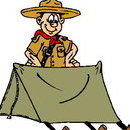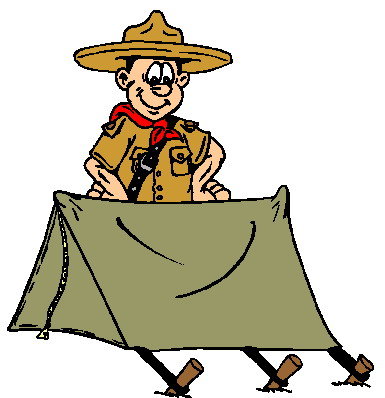-
Posts
366 -
Joined
-
Last visited
-
Days Won
6
Content Type
Profiles
Forums
Articles
Store
Everything posted by Double Eagle
-
You are getting a lot of good advice on this topic. Hopefully I can add to it. A subtle way for the adults to see the importance may be for their Scouts to set the example. Focus on them first. Adult Scouters used to have BSA ties, suits, as well as the field uniform, don't see them much anymore. Some adults may pay the bill for their Scout (we know sticker shock on uniforms) and just use an activity shirt. 1. Do you participate with other units on outings or council collective events? Do they see other Scouts in uniform, assist as staff on Cub Day Camp, NYLT, etc? At some staffed summer camps, uniform is required at breakfast and dinner. Expose them to other uniformed Scouts and it may help. 2. Is price one reason for not being in uniform? Uniform exchange or donations may be an option. Most of the "seasoned" scouters on this forum probably have a stash of old uniforms that shrunk as they got older. 3. As mentioned about uniform inspection, start the Scouts doing this weekly with monthly acknowledgement/prize. As a pre-opening, how about "Pin the patch on the Uniform" game. I wonder how a court of honor is handled, whether a MB sash is worn over a T-shirt? If there are OA members, how do they handle uniforms at lodge meetings/events? Lastly, 4. Has the PLC put in place any uniform guidance? What do they say about neckerchiefs, bolos, or nothing? During fund raising or recruiting, how about stressing uniforms be worn. A pack I know does monthly pancake breakfasts at the chartered organization and cubs at least wear the field shirt/neckerchief. This lets customers know and see it is a Scout event rather than another church group.
-
You (the SM) can easily appoint Scout A as a JASM provided he is 16yrs old. Not for just camp, but for his regular position. Scout A is not new to scouting or camp so supporting the camp SPL should be easy. A great time (one week) to see how the ASPL can do in the SPL position. If he won't or cannot, may be a good time for some reflection and SM conference.
-
I'm leaning on the ASPL taking over duties for the SPL. Scout A could probably do a fine job. NYLT is not a requirement to lead, hopefully the troop had a recent ILST for their Scout leaders at a minimum. Scout A has an Eagle BOR scheduled. If Scout A is going to camp...what are they doing? Scout B will get more out of the temporary position and shows reinforcing the chain of command. Scout B, if not used, may just back off duties as ASPL if not used. Camps will mainly only work with the SM and SPL mainly for communication/duties etc. Scout B will get more out of the experience. If there are additional areas that need attention, how about Scout A support by being troop ASPL at camp?
-
I may see this from a different side. I'm in favor of the CO having acknowledgment for anything their chartered unit does. If the CO offers a place to meet, charter, camper-ships, equipment, fund-raising, and other support...an advertisement is a small concession and thank you. If the CO is mentioned on activity (class B) clothing/scarves so be it. I've had many CO symbols and wording on neckerchiefs that generated some great conversations. Here is my hardcore stance: If any one person objects to the CO mentioned on clothing, that one person is never wrong to be in full BSA uniform (field uniform). CO are not an obstacle or hindrance, but rather a full supporter that should be involved more than just an annual recharter signature.
-

Position Specific Training
Double Eagle replied to 5thGenTexan's topic in Wood Badge and adult leader training
Don't overlook your commissioners help with this. Commissioners have access to training records that say what course(s) each person is missing. Recently I reviewed a district's training with only 44% position-specific trained. That means 56% of unit/MB leaders are going with only their experience with programs, and most of them are Pack Leaders. When all else fails, a council nasty-gram to the chartered organization rep may help to energize those leaders. Although some may be repetitive and boring, the on-line training is easy. Hard to tell Scouts there are requirements when the adults don't follow their requirements. -

Scoutmaster Requirements to Advance
Double Eagle replied to ScoutDad197's topic in Open Discussion - Program
Sorry for my earlier post as I was typing with fingers of fire. I couldn't have left off a more important "not" in my sentence of "A SM conference is NOT always an "end of requirements", one-time thing". I apologize for the error, but for those that read my entire post may have caught my error. -

Scoutmaster Requirements to Advance
Double Eagle replied to ScoutDad197's topic in Open Discussion - Program
Ok, this SM is way out there on his duties. A SM conference is always an "end of requirements", one-time thing. A SM conference can be held anytime, can be casual talk around the campfire, during a meal, or a formal uniformed sit down. I did SM conferences if a scout slowed down, attendance dropped, saw a change in the scout. They can also be for positive aspects such as being elected to the OA or troop leader position. This SM is missing so much by trying to test the scouts. Nothing worse than putting the stress of the "test" to a scout. How about watching the scout and when they do something correct, it gets acknowledged. This could be as simple as using a taut-line hitch on a tent rope at an outing. I always get a laugh when students would ask "is this testable". My response usually was "everything is testable, just the time is different". -
The yells can be used whenever a troop assembles. I've seen it routinely as mentioned above and to hold roll call. At opening campfires, flagraising gatherings, anytime you need the scouts to settle down and get their attention. At Woodbadge after flag call, pawe always asked if there were any... and they responded with their patrol critter's yell.
-
At $43 a hat, you better keep the strap under the chin and not leave it laying around. As if the $24 cub and scout hats aren't crazy enough. How about we reuse neckerchiefs like this:
-
This is sounding like a Wood Badge ticket item of putting together a "Feed-O-Ree" where units can show different levels and methods of meals. A lot of good ideas out there. And Scouts could knock out some cooking requirements.
-
I may be missing something on this. I would describe the Eagle advisor as someone in the troop that focuses on the Life Scouts (like an ASM) to teach, coach, and mentor them to complete what they want and started. I think the project part is bigger than the advisor's role. Most projects takes troops(s), organizations, packet write up, resources, etc. I know of district and council folks that nit-pick a proposal and ok. As an Eagle advisor, I'd want all the help I can get to get the project approved, executed, and finalized. As for the Eagle application, BOR, and records, it could take the committee to track everything if record keeping is shabby. And for those that read to the bottom of the post: The youngest Eagle Scout was 11yrs old. Not many 11yr olds have the skills, knowledge, and attitude to complete Eagle projects, BOR, and application.
-
A lot of good advice already. Boy did you ask for it. And I'm gunna ruffle feathers too. 1. Keep it at the patrol level. Every scout should be able to do it and maybe check off some advancement needs. 2. Avoid troop cooking where the adults helicopter the whole time. 3. Teach them to actually cook from basic ingredients. Adults should not handle a utensil, unless preparing their own food. 4. Have the adults on the same budget or ingredients and show what is possible. 5. Eggs? Omelets in a bag are quick, easy clean up, and cater to each scout. 6. Plan meals based on activities. Short prep and cooking when they are crunched for time (lunch or opening). Long elaborate meals when you have the time. 7. Dutch oven dessert every night. 8. Stay away from the hotdogs, poptarts, donuts (unless making them), etc. 9. Challenge older scouts to cook like eggs in an orange peel, caveman steak, bacon in a bag, etc. 10. Keep it fun.
-

how Scouts sign up for outings
Double Eagle replied to RainShine's topic in Open Discussion - Program
This just touched a nerve with me. This is terrible to tell or have the Scouts know this is what cancelled their outing. I try to let units know if they have to cancel an event due to lack of adults, let their commissioner staff know asap and see if they can help get it covered. Lack of adults participating is different than having enough trained adults attending. For the well-seasoned adults, some of us remember filing trip plans/reports for council approval before you could go. Some did it, some just went. I can't imagine withholding outing information from parents or scouts. The more notice, but better. And, some may just come for the site location. -
May tick off a few folks on this one. Kudos to all the volunteers that support and make our programs run. Without them at the unit, district, and council, the BSA would shut down. Years back they merged "of like" knots, did away with some (Tiger Den Leader Coach, Orange and Black)). There was some good and bad in the changes. Here's what I recommend to units: Have a rotation (no more than 3yrs) in any one position. New ideas, opportunities, and positions can keep a fresh program. Most leaders can complete requirements for their position in that 3yrs. Also, have someone on the unit committee track "adult advancement" like someone does for Scouts. We put a lot on our volunteer's plates, at least we can recognize them through BSA practices. The Scouts like to see their leaders get awards too.
-

2023 National Jamboree - Cost/Attendance
Double Eagle replied to HashTagScouts's topic in Open Discussion - Program
Here's more a question for those familiar with Summitt. I am taking a short drive as a guest visitor to the reserve during the Jamboree. Need some help identifying the "must see" portions of the reserve/jamboree. I've attended jamborees at A.P. Hill, but I'm sure it's just not the same. I have a 6hr pass and want to see the best of the site. -

Halloween costume by celebrity looks genuine
Double Eagle replied to Laxplr21's topic in Open Discussion - Program
Seeing him in the news in the past few days about being a den leader for his son's lion den is pretty cool. There is a photo of him on the web from his Philmont trek in the 90s. About time to see public-eye folks shed some positivity in Scouting. Maybe he can turn a page and put his celebrity status to use. -
I seem to remember using the neckerchief for SM minutes with the 3 edges as 3 parts of the scout oath and 12 rolls for the scout law. Also, as the last uniform item put on, the scout oath and law are the last part of the uniform. This is a really reduced SM minute and roll tight as 12 is a lot with smaller neckers.
-
As we saw in the 2019 World Jamboree, the neckerchief is the one noticeable item that makes a scout stand out and IDs a scout. Boy's Life used to run a monthly neckerchief slide build, don't remember the years of this.
-
Sadly, I think there is a slow death happening. Cubs has taken a drastic membership decline. Competing programs like GS or TL are getting more participation for the simple pricetag. The latest selling of camps for restitution, increased membership fees, and decades of fundraising emphasis like FOS/popcorn just kills our reputation. As a lifelong scout/scouter, I miss the days where any youth could join with just a few bucks from grass cutting. Gear and uniforms were passed to new scouts, and almost every family could afford to send a scout to summer camp. Emphasis was on camp skills and outings, even if the same camp every month. You just don't hear a lot from the non-scouting world about the importance of being an Eagle Scout. It is mirrored in the OA where you have: Sash and dash, brotherhood and bounce, vigil and vanish. Holding my breath, the program survives, but needs a 911 call for life support in almost all areas.
-
Yup, upstate NY was a great scout stomping grounds for me and my sons. Camp Portaferry near the Watertown area was the bomb. A lot of good info so far. I may have missed it, but don't neglect ground insulation for tents. You can put interlocking foam matting (gym type) inside your tents to add a great deal of insulation while sleeping. You will need to look at the footprint and maybe cut some vs overlapping excess. The other method I used as a scout in Michigan in the 70s with floorless canvas scout tents was spreading loose bales of straw as an insulation floor. This was pretty cheap and readily available. A few things to note on this method: NO flames in tents! A ground tarp/cloth between the ground and straw may help. Small items can easily be lost in the loose straw. When departing, do a good a sift through the straw for knives and things. A campmaster may direct you how they want the excess straw disposed or reused. Back to your OP, if you will seldomly camp with those temps, avoid the high price of new wool products. The earlier posts have the best advice for this.
-

Question about local group requirements
Double Eagle replied to Mismatched_Socks's topic in New to Scouting?
Based on the initial question about mandatory participation, you answered the question by asking it. If you have to wonder about a unit, avoid it. They should be selling their program to you, so you join their unit. As a commissioner, I had to get involved with a unit that decided to have "try outs" by performing woodcraft-type skills. Imagine that, try outs to join where you would learn such things. I don't know of any unit that has 100% participation by scouts in every event. It is really unimaginable. If that unit has that as an enforced guideline, that is one unit that needs help from district and/or council. -
With all the badge experience, what a great time to flood the room with reading material for an eagle-type project (not just a one-time deal) and start getting ideas on that. If an OA member, how about starting a "where to go camping" guide for new units with information gathered from her network. This is an opportunity to draft a scouting event/program for those confined to a room or bed. Turn this into a learning opportunity and get others involved so she is not alone in this endeavor.
-
Not sure just how much pioneering is going to be used, but please don't skip the event. They scouts will get something out of it no matter the outcome. You have a ton or resources to help your inexperienced unit. Reach out any commissioner or OA member to assist. If there are eagle scouts in the area that may help grab them up. If you have a district roundtable (from the district/council calendar) bring this up as a need. From your original post, its uncertain whether you have to build a sled from pioneering material, or this is just a station at the derby. Bottom line: reach to local resources around you. You are never alone in scouting.
-

Saws, knives, and training to prevent unkind cuts
Double Eagle replied to Mrjeff's topic in Open Discussion - Program
This is going to touch a nerve (pun intended), are we still cutting corners from Totin Chips? As a longtime scouter from the 70s until now, I think that practice really doesn't make sense anymore. We don't burn corners from Fireman chit that I know of. I think cutting corners is the only thing I've seen in Scouting where this type of result happens from being "unsafe". Just some posted comments mention how common injuries are. I think we need an azimuth check whether this is still a necessary practice. Confusing like this example: At one camp, scouts were not allowed fixed blade knives. This intent was for pocket type knives without any specifics given. But, every chef kit had a paring knife and 8" carving knife. Doesn't really make sense to me. Also, there was no size limit on the folding knives. We won't even mention how machetes in Panama were carried by about every scout. Crazy standards/rules sometimes.- 41 replies






